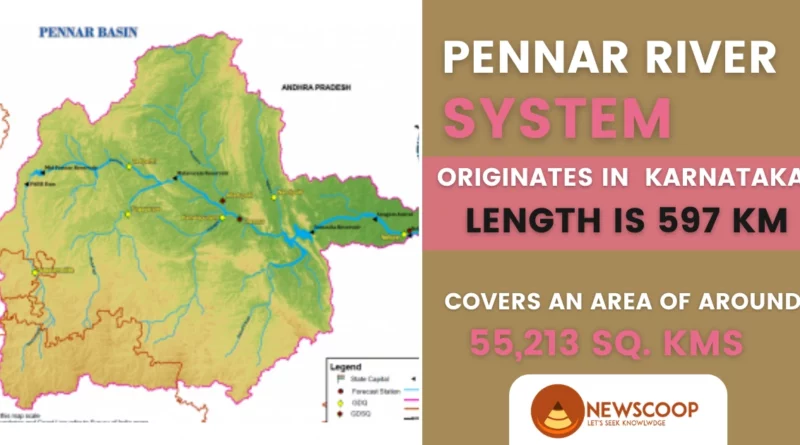Pennar River: Left and Right Bank Tributaries | Dams, Map & Location for UPSC
The Pennar River is a significant river in the southern part of India. It flows through the states of Andhra Pradesh, Karnataka, and Tamil Nadu. The river is approximately 597 kilometers in length and has a catchment area of 55,213 square kilometers. The river is a major source of water for irrigation, hydroelectric power generation, and industrial usage in the region.
In this article, we will discuss the Pennar River’s geography, history, dams, tributaries, significance, and the challenges it faces.
History of Pennar River
The Pennar River has been an important river in the region for centuries. It was mentioned in the ancient Indian texts of the Rigveda and Mahabharata. The river played a significant role in the Vijayanagara Empire’s history, providing water for irrigation and supporting agriculture. The river’s water was also used for the construction of the famous Hampi temple complex.
During the British colonial period, the river’s water was used for irrigation and the generation of hydroelectric power. Several dams and reservoirs were constructed on the river to support these activities. The river’s water was also used for industrial purposes, and several factories were built along its banks.
Geographical Features of Pennar River for UPSC
Here are some geographical features of the Pennar River:
- Origin: The Pennar River originates in the Nandi Hills of Karnataka and flows through the Deccan Plateau.
- Length: The river is approximately 597 kilometers in length.
- Catchment area: The river has a catchment area of 55,213 square kilometers.
- Flows through: The river flows through several districts of Andhra Pradesh, such as Anantapur, Kurnool, Kadapa, and Chittoor. The river then enters Tamil Nadu and finally empties into the Bay of Bengal near the town of Cuddalore.
- Terrain: The river’s upper catchment is characterized by rocky terrain and sparse vegetation, while the lower catchment is more fertile, with a higher density of forests and agriculture.
- Biodiversity: The river’s basin is home to several species of plants and animals, including the critically endangered Jerdon’s courser and the Indian eagle owl.
- Dams and reservoirs: Several dams and reservoirs have been constructed on the river to support irrigation and hydroelectric power generation, such as the Srisailam Dam.
- Water usage: The river’s water is used for irrigation, hydroelectric power generation, industrial purposes, and drinking purposes, although the quality of the water is a concern due to pollution and industrial waste.
- Water levels: The overexploitation of the river’s water has led to a decline in the river’s water levels, especially during the summer months, impacting the river’s ecosystem and affecting the livelihoods of people who depend on the river for irrigation and fishing.
Tributaries of Pennar River for UPSC
The Pennar River has several left and right tributaries that contribute to its water flow. Here are some of the significant tributaries of the Pennar River:
Left Tributaries:
- Jayamangali River: The Jayamangali River is a left tributary of the Pennar River. The river originates in the Devarayanadurga hills of Karnataka and flows through the districts of Tumkur and Chitradurga before joining the Pennar River in Andhra Pradesh. The Jayamangali River is a seasonal river that has a length of approximately 103 kilometers. The river is an important source of water for irrigation and groundwater recharge.
- Kunderu River: The Kunderu River is another left tributary of the Pennar River. The river originates in the Nallamala Hills of Andhra Pradesh and flows through the districts of Kurnool and Anantapur before joining the Pennar River. The Kunderu River is a seasonal river that has a length of approximately 240 kilometers. The river is an important source of water for irrigation and supports the cultivation of crops such as cotton and groundnut.
- Sagileru River: The Sagileru River is a left tributary of the Pennar River. The river originates in the Eastern Ghats of Andhra Pradesh and flows through the districts of Chittoor and Nellore before joining the Pennar River. The Sagileru River is a seasonal river that has a length of approximately 200 kilometers. The river is an important source of water for irrigation and groundwater recharge.
- Cheyyeru River: The Cheyyeru River is a left tributary of the Pennar River. The river originates in the Eastern Ghats of Andhra Pradesh and flows through the districts of Nellore and Cuddapah before joining the Pennar River. The Cheyyeru River is a seasonal river that has a length of approximately 240 kilometers. The river is an important source of water for irrigation and supports the cultivation of crops such as paddy and sugarcane.
- Papagni River: The Papagni River is a left tributary of the Pennar River. The river originates in the Eastern Ghats of Andhra Pradesh and flows through the districts of Chittoor and Kadapa before joining the Pennar River. The Papagni River is a seasonal river that has a length of approximately 170 kilometers. The river is an important source of water for irrigation and groundwater recharge.
Right Tributaries:
- Kundu River: The Kundu River is a right tributary of the Pennar River. The river originates in the Nallamala Hills of Andhra Pradesh and flows through the districts of Prakasam and Nellore before joining the Pennar River. The Kundu River is a seasonal river that has a length of approximately 150 kilometers. The river is an important source of water for irrigation and groundwater recharge.
- Chitravathi River: The Chitravathi River is another right tributary of the Pennar River. The river originates in the Anthapur district of Andhra Pradesh and flows through the districts of Anantapur and Kadapa before joining the Pennar River. The Chitravathi River is a seasonal river that has a length of approximately 260 kilometers. The river is an important source of water for irrigation and groundwater recharge.
- Galeru River: The Galeru River is a right tributary of the Pennar River. The river originates in the Nallamala Hills of Andhra Pradesh and flows through the districts of Kurnool and Kadapa before joining the Pennar River. The Galeru River is a perennial river that has a length of approximately 110 kilometers. The river is an important source of water for irrigation and hydroelectric power generation.
- Bahuda River: The Bahuda River is a right tributary of the Pennar River. The river originates in the Eastern Ghats of Andhra Pradesh and flows through the districts of Nellore and Chittoor before joining the Pennar River. The Bahuda River is a seasonal river that has a length of approximately 130 kilometers. The river is an important source of water for irrigation and groundwater recharge.
These tributaries are an important source of water for the Pennar River and support the region’s irrigation, hydroelectric power generation, and industrial activities.
Dams on Pennar River
1. Somasila Dam
The Somasila Dam is a major dam built across the Pennar River in the Nellore district of Andhra Pradesh. It is a multipurpose project constructed for the purpose of irrigation, flood control, and hydroelectric power generation.
The dam has a height of 47 meters and a length of 1,665 meters. The reservoir created by the dam has a storage capacity of 15.42 thousand million cubic feet (TMC). The water from the reservoir is utilized for irrigation of over 250,000 acres of land in the surrounding areas.
2. Kandaleru Dam
The Kandaleru Dam is a major dam built across the Kandaleru River, which is a tributary of the Pennar River, in Andhra Pradesh. The dam has a height of 49 meters and a length of 1,880 meters.
The reservoir created by the dam has a storage capacity of 68.48 TMC. The water from the reservoir is utilized for irrigation of over 70,000 acres of land in the surrounding areas, as well as for drinking water supply to several towns and cities in Andhra Pradesh and Tamil Nadu.
3. Gandikota Dam
The Gandikota Dam is a major dam built across the Pennar River in the Kadapa district of Andhra Pradesh. It is a multipurpose project constructed for the purpose of irrigation and hydroelectric power generation.
The dam has a height of 52 meters and a length of 1,178 meters. The reservoir created by the dam has a storage capacity of 3.99 TMC. The water from the reservoir is utilized for irrigation of over 35,000 acres of land in the surrounding areas, as well as for hydroelectric power generation.
4. Mylavaram Dam
The Mylavaram Dam is a major dam built across the Pennar River in the Kadapa district of Andhra Pradesh. It is a multipurpose project constructed for the purpose of irrigation and hydroelectric power generation.
The dam has a height of 48 meters and a length of 710 meters. The reservoir created by the dam has a storage capacity of 4.48 TMC. The water from the reservoir is utilized for irrigation of over 21,000 acres of land in the surrounding areas, as well as for hydroelectric power generation.
These dams on the Pennar River have been instrumental in meeting the irrigation and power needs of the surrounding regions. However, they also face challenges such as siltation, sedimentation, and encroachment, which affect their efficiency and lifespan. Hence, regular maintenance and periodic desilting are necessary to ensure their smooth functioning and longevity.
Conclusion
The Pennar River is a significant river in the southern part of India, providing water for irrigation, hydroelectric power generation, and industrial usage. The river has a rich history and cultural significance in the region. However, the river faces several challenges, including pollution, overexploitation, and declining water levels.
It is essential to take measures to protect and conserve the river’s water resources for sustainable development and the well-being of the people and the environment.
Thank You!
Related Links:

